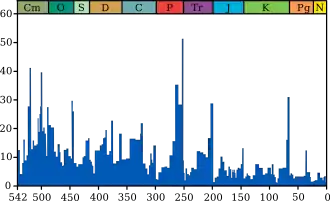انقراض البرمي-الثلاثي
انقراض العصر البرمي الثلاثيالمعروف باسم الموت العظيم [3] هو انقراض جماعي وقع قبل 251.4 مليون سنة،[4] في الفترة بين العصرين الجيولوجيين البرمي والثلاثي. كان هذا الحدث أكبر حالة انقراض شهدتها الأرض، والذي قضى على نحو 96 ٪ من كل أنواع الأحياء البحرية،[5] وانقراض نحو 70 ٪ من كل أنواع الفقاريات الأرضية.[6]
| انقراض البرمي-الثلاثي | |
|---|---|
يبين الرسم البياني الأزرق نسبة واضحة (ليس عدد مطلق) لأجناس الحيوانات البحرية المنقرضة خلال أي فترة زمنية معينة. ولا تمثل جميع الأنواع البحرية، بل فقط التي تحجرت بسهولة. التسميات لأحداث الانقراض "الخمسة الكبرى" هي روابط قابلة للنقر؛ لمزيد من التفاصيل انظر احداث الانقراض.(معلومات المصدر والصورة)
| |
| نوع الانقراض | انقراض جماعي |
| عصر الانقراض | البرمي - الثلاثي |
| تاريخ الانقراض | قبل 251.4 مليون سنة |
| سبب الانقراض | تغير تدريجي للمناخ اصطدم نيزك متفجر انفجارات بركانية كبيرة |
| نسبة الكائنات المنقرضة |
96% من الأنواع البحرية 70% من كل أنواع الفقاريات الأرضية. |
كما يعد هذا الانقراض هو الانقراض الجماعي الوحيد المعروف للحشرات.[7] انقرضت نحو 57 ٪ من كل العائلات و 83 ٪ من جميع الأجناس. نظرًا لفقد الكثير من التنوع البيولوجي، استغرق الأمر وقتًا أطول لعودة الحياة على الأرض مقارنةً بحالات الانقراض الأخرى.[5] وقد وصفت هذا الحدث بأنه "أم كل الانقراضات الشاملة".[8]
يعتقد الباحثون أن هذا الانقراض تم من خلال مرحلة إلى ثلاث مراحل.[4][6][9][10] هناك العديد من الآليات المقترحة لحدوث هذا الانقراض، أولى مراحل الانقراض سببه حدوث تغير بيئي تدريجي، في حين المرحلة التالية ترجع إلى حدوث كارثة. المراحل الأخيرة تشمل اصطدام نيزك كبير أو نيازك متعددة، مع ثورات البراكين الضخمة ونيران الفحم أو الغاز والإنفجارات من مصاطب سيبيريا[11]، واندفاع غاز الميثان من قاع المحيطات مسببًا تأثير البيت الزجاجي. شملت أيضًا التغيرات التدريجية تغير مستوى سطح البحر وحدوث نقص في الأكسجين وزيادة التصحر، والتغير في دوران المحيطات بسبب التغيرات المناخية.
مراجع
- Munnecke, A.; Samtleben, C.; Bickert, T. (2003). "The Ireviken Event in the lower Silurian of Gotland, Sweden-relation to similar Palaeozoic and Proterozoic events". Palaeogeography, Palaeoclimatology, Palaeoecology. 195 (1): 99–124. doi:10.1016/S0031-0182(03)00304-3. الوسيط
|CitationClass=تم تجاهله (مساعدة) - Jeppsson, L.; Calner, M. (2007). "The Silurian Mulde Event and a scenario for secundo—secundo events". Earth and Environmental Science Transactions of the Royal Society of Edinburgh. 93 (02): 135–154. doi:10.1017/S0263593300000377. الوسيط
|CitationClass=تم تجاهله (مساعدة) - Barry, Patrick L. (January 28, 2002). "The Great Dying". Science@NASA. Science and Technology Directorate, Marshall Space Flight Center, NASA. مؤرشف من الأصل في 09 مارس 2010. اطلع عليه بتاريخ 26 مارس 2009. الوسيط
|CitationClass=تم تجاهله (مساعدة); تحقق من التاريخ في:|تاريخ أرشيف=(مساعدة) - Jin YG, Wang Y, Wang W, Shang QH, Cao CQ, Erwin DH (2000). "Pattern of Marine Mass Extinction Near the Permian–Triassic Boundary in South China". Science. 289 (5478): 432–436. doi:10.1126/science.289.5478.432. PMID 10903200. الوسيط
|CitationClass=تم تجاهله (مساعدة)صيانة CS1: أسماء متعددة: قائمة المؤلفون (link) -
Benton M J (2005). When Life Nearly Died: The Greatest Mass Extinction of All Time. Thames & Hudson. ISBN 978-0500285732. الوسيط
|CitationClass=تم تجاهله (مساعدة) - Sahney, S. and Benton, M.J. (2008). "Recovery from the most profound mass extinction of all time" (PDF). Proceedings of the Royal Society: Biological. 275 (1636): 759. doi:10.1098/rspb.2007.1370. PMC 2596898. PMID 18198148. مؤرشف من الأصل (PDF) في 12 أغسطس 2018. الوسيط
|CitationClass=تم تجاهله (مساعدة)صيانة CS1: أسماء متعددة: قائمة المؤلفون (link) - Sole, R. V., and Newman, M., 2002. "Extinctions and Biodiversity in the Fossil Record - Volume Two, The earth system: biological and ecological dimensions of global environment change" pp. 297-391, Encyclopedia of Global Environmental Change John Wiley & Sons.
- Erwin DH (1993). The great Paleozoic crisis; Life and death in the Permian. Columbia University Press. ISBN 0231074670. الوسيط
|CitationClass=تم تجاهله (مساعدة) - Yin H, Zhang K, Tong J, Yang Z, Wu S. "The Global Stratotype Section and Point (GSSP) of the Permian-Triassic Boundary". Episodes. 24 (2): 102–114. الوسيط
|CitationClass=تم تجاهله (مساعدة)صيانة CS1: أسماء متعددة: قائمة المؤلفون (link) - Yin HF, Sweets WC, Yang ZY, Dickins JM,. "Permo-Triassic Events in the Eastern Tethys". Cambridge Univ. Pres, Cambridge, 1992. الوسيط
|CitationClass=تم تجاهله (مساعدة)CS1 maint: extra punctuation (link) صيانة CS1: أسماء متعددة: قائمة المؤلفون (link) - Darcy E. Ogdena and Norman H. Sleep (2011). "Explosive eruption of coal and basalt and the end-Permian mass extinction". Proceedings of the National Academy of Sciences of the United States of America. 109: 59–62. Bibcode:2012PNAS..109...59O. doi:10.1073/pnas.1118675109. مؤرشف من الأصل في 19 فبراير 2019. الوسيط
|CitationClass=تم تجاهله (مساعدة)
وصلات خارجية
- "The Permo–Triassic extinction" Introduction.
- "The Permo–Triassic extinction" A more detailed introduction. Bibliography. Archive.org link
- "Siberian Traps Website"
- BBC2 'The Day the Earth Nearly Died' website.
- PBS series Evolution: "Extinction!" video segment
- Luann Becker, "Exploring Antarctica: Understanding Life on Earth and Beyond": includes links to scientific papers
- SpaceRef: "Big Bang in Antarctica: Killer Crater Found Under Ice" Radar images courtesy of Ohio State University.
- Science Daily: Global warming led to atmospheric hydrogen sulfide and Permian extinction
- Science Daily: Big Bang In Antarctica: Killer Crater Found Under Ice
- Lee Siegel, "Rocks Reveal Details of Mass Extinction" Based on Peter D. Ward, David R. Montgomery, Roger Smith, "Altered River Morphology in South Africa Related to the Permian–Triassic Extinction", in Science 8 September 2000
- David Morrison, "Did an Impact Trigger the Permian–Triassic Extinction?"
- Giant Crater Found: Tied to Worst Mass Extinction Ever Robert Roy Britt (SPACE.com) 1 June 2006 06:07 p.m. ET
- Rocks Reveal Details of Mass Extinction Lee Siegel (SPACE.com) 02:44 p.m. ET 7 September 2000
- The History Files: Permian Extinction Event BBC News extract
- Ward, P.D. (2006) "Impact from the Deep". Scientific American October 2006.
- بوابة علم الأحياء التطوري
- بوابة علوم الأرض
- بوابة علم الأحياء القديمة
- بوابة الفضاء
- بوابة الأنواع المنقرضة والمهددة بالانقراض
